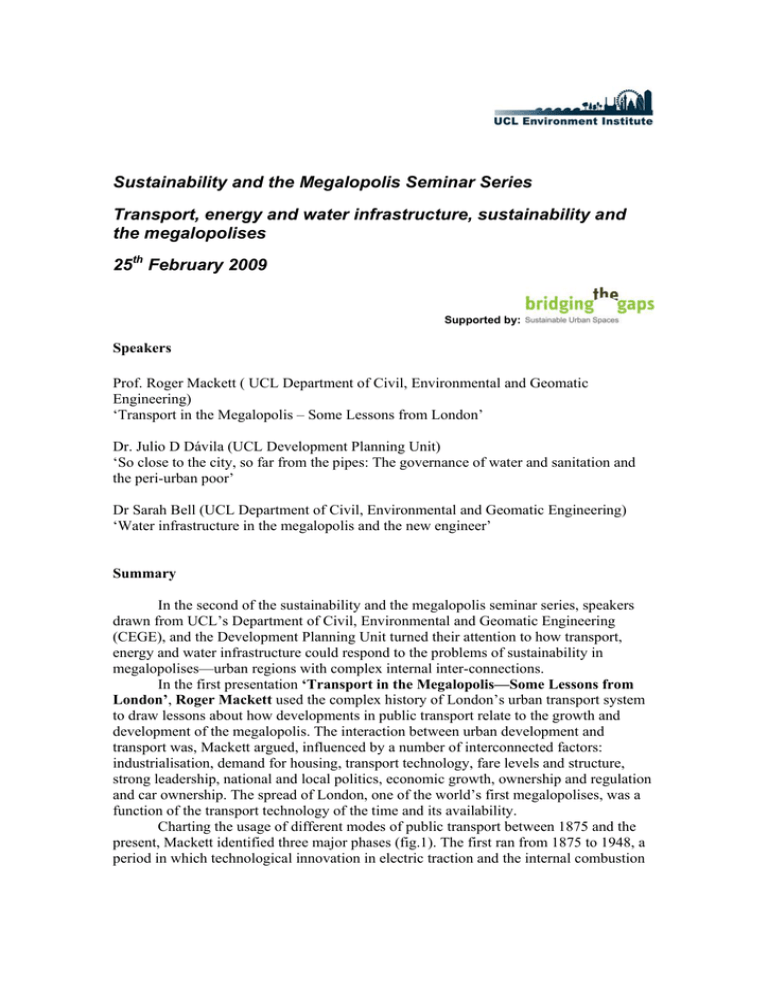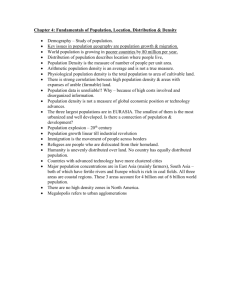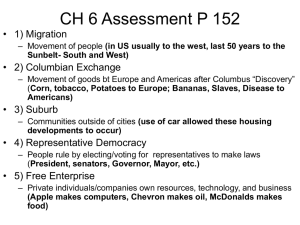Sustainability and the Megalopolis Seminar Series
advertisement

Sustainability and the Megalopolis Seminar Series Transport, energy and water infrastructure, sustainability and the megalopolises 25th February 2009 Supported by: Speakers Prof. Roger Mackett ( UCL Department of Civil, Environmental and Geomatic Engineering) ‘Transport in the Megalopolis – Some Lessons from London’ Dr. Julio D Dávila (UCL Development Planning Unit) ‘So close to the city, so far from the pipes: The governance of water and sanitation and the peri-urban poor’ Dr Sarah Bell (UCL Department of Civil, Environmental and Geomatic Engineering) ‘Water infrastructure in the megalopolis and the new engineer’ Summary In the second of the sustainability and the megalopolis seminar series, speakers drawn from UCL’s Department of Civil, Environmental and Geomatic Engineering (CEGE), and the Development Planning Unit turned their attention to how transport, energy and water infrastructure could respond to the problems of sustainability in megalopolises—urban regions with complex internal inter-connections. In the first presentation ‘Transport in the Megalopolis—Some Lessons from London’, Roger Mackett used the complex history of London’s urban transport system to draw lessons about how developments in public transport relate to the growth and development of the megalopolis. The interaction between urban development and transport was, Mackett argued, influenced by a number of interconnected factors: industrialisation, demand for housing, transport technology, fare levels and structure, strong leadership, national and local politics, economic growth, ownership and regulation and car ownership. The spread of London, one of the world’s first megalopolises, was a function of the transport technology of the time and its availability. Charting the usage of different modes of public transport between 1875 and the present, Mackett identified three major phases (fig.1). The first ran from 1875 to 1948, a period in which technological innovation in electric traction and the internal combustion engine, municipalisation, and strong leadership in private enterprise saw the steady growth of transport provision and usage. The second phase between 1948 and 1981 saw the factors such as the nationalisation of public transport, Government interference, and increased car ownership contribute to a period of steady decline. And finally, the third phase running between 1981 to the present saw an increase in passenger numbers initiatives such as Ken Livingstone and the GLC’s ‘Fares Fair’ campaign in the 80’s, the introduction of zonal fares and travelcards, economic boom time, investment in the Docklands Light Railway and Jubilee Line, and the introduction of congestion charging in 2003. Public transport in London 5000 Phase 1 Phase 2 Phase 3 Million trips per year 4500 4000 3500 3000 2500 2000 1500 1000 500 18 75 18 95 19 13 19 21 19 30 19 34 19 39 19 48 19 54 19 62 19 66 19 71 19 76 19 19 81 85 19 /86 91 19 /92 96 20 /97 01 20 /02 06 /0 7 0 Underground Tram Bus Trolley-bus DLR Total fig.1. Studying the factors that influenced these phase transitions would, Mackett argued, enable us to draw certain lessons. First, no public transport system can cover all of its costs, thus government subsidy is always required. It is unclear, however, whether public or private ownership is better: in either case central government interference can be detrimental to investment and prevent sound operational decisions being made. Second, if one looks to introduction of congestion charging, innovation is encouraged by a number of factors. A champion of the scheme is needed, technology must be tried and tested, powerful lobbies must be kept in support, and the public consultation should be used with caution. Heeding the lessons taken from London’s transport history could thus help engineer the shape and the future of our megalopolises. Julio Dávila, in a presentation produced jointly with Adriana Allen of the DPU, went on to address the role of water infrastructures in shaping the speed and type of growth of the megalopolis in his presentation ‘So close to the city, so far from the pipes: The governance of water and sanitation and the peri-urban poor’. Drawing on general, comparative and applied research conducted as part of the Peri-urban Interface Programme (www.ucl.ac.uk/dpu/pui) Dávila’s presentation focused on the problems of water infrastructure in 5 cities that represented different sets of governance situations: Mexico City, Caracas, Cairo, Dar es Salaam and Chennai. Access to treated water is essential to the growth and survival of urban regions, and so although access has generally improved worldwide (fig.2), further improvements are still vital in order to combat the diseases that contribute to high mortality and infant mortality rates (fig.3). fig.2 fig.3. Although reticulated water systems designed by engineers and provided by the public sector have made major improvements to water access in the main conurbations of the 5 cities studied, the fast growing peri-urban areas are, in the main, neglected by large regulated frameworks. Poor water resources in peri-urban contexts, however, cannot be explained by the unsustainable growth of cities; in fact, Dávila argued, there is no correlation between city-size and the sustainability of water resources. Issues surrounding the sustainable extraction, supply and consumption of water were better explained by hydrological systems, water governance regimes (the institutional dimensions of the provision of access to water), water demand and consumption patterns (influenced by lifestyle), and socio-economic inequality. Alternative solutions would have to be found to take into account the difficulty of creating reticulated systems for such fast-expanding areas, and whether such a provision is actually desired in sustainability terms. Policy-makers would instead have to look at decentralised methods of distribution of treated water, allowing, for instance, local communities to manage their own water supply and sanitation, resolving conflicts over access to peri-urban aquifers, and controlling the price-fixing of local cartels without stopping small-scale suppliers. A new water culture could thus be created that might make the supply of water a co-production between state and citizens, empowering periurban communities and groups within those communities, such as women, by enabling them to manage their own water supplies. Co-production and provision of infrastructures that involve consumers in the creation of their own water-infrastructure present fundamental challenges to the conventional expert-led engineering model of infrastructure provision, and thus Sarah Bell considered the role of ‘Water infrastructure in the megalopolis and the new engineer’. Cities, Bell argued, were increasing their demands for water, when supplies are limited and may decrease as the effects of climate change become more apparent. Bell thus addressed the underlying challenges facing infrastructure provision and their implications for engineers, citizens and our processes of urban decision making. Recent social and cultural research has shown that consumption itself is shaped by infrastructure. While demand management campaigns tell customers that water is a limited resource, infrastructure actually tells them the opposite. The endless supply of water has created new cultural practices and expectations that are harder to shift than simply telling consumers about falling reservoir levels. Educational campaigns on the usage of water are ineffective when engineers have not just responded to demand, but created it, in the infrastructure they have provided. Rather than viewing consumers as nodes of demand for infrastructure to supply, the demands of sustainability require engineers and planners to open up infrastructure to citizens to conceive of new ways of supplying cultural expectations of water. Water-scarce regions, such as the south-east England, have reached their hydrological limits. Desalination and the treatment and reuse of waste water are thus seen as alternatives. Potable reuse involves treating water to a very high standard and then reintroducing this water to reservoirs, rivers and aquifers before being abstracted again and going through the usual treatment (fig.4). Public opposition campaigns have, in the P lanned R eus e Water Treatment Works R iver Town Wastewater Treatment Works Water Treatment Works Advanced Treatment Works T ha mes W a ter 6 fig.4 Wastewater Treatment Works Town S ea past, closed down waste water treatment works, as PR campaigns, working on a deficit model of public understanding have unsuccessfully tried to persuade consumers of the safety of the technology. When it comes to new supplies, the public is no longer willing to trust the engineers to make technical decisions in their best interests. Alternative decision making networks must, therefore, be found. Working with Thames Water on the feasibility of potable reuse systems, Bell and others have been involved with deliberative forums that give members of the public the opportunity to question engineers on new technologies. Ideally, these deliberative forums would be delegated the authority to make the decisions. Thames Water have not gone this far, however, this pilot scheme showed that more democratic methods of decision making could be beneficial, as the public became more favourable to potable reuse after deliberation. Although engineers are still powerful actors, new models of decision making have thus been created in response to the need to make difficult decisions about future water supplies in democratic contexts. Four main themes emerged from the presentations and the discussion that followed. 1. Scales and Infrastructure In an overview of the Foresight Report on Energy Management and the Built Environment, Yvonne Rydin noted how the report, much like Mackett’s presentation, had looked at the different infrastructural scales used in different periods, considering municipalisation, nationalisation, and marketised systems. Questions thus emerged as to whether large scale infrastructural models should, in fact, be broken up, or have smallscale models built within them in order to take into account the diverse, informal systems that exist in megalopolises. The role of local government, and strong leaders and personalities within that government were seen to be vital. The nineteenth-century heads of private companies who effected enormous change to the capital’s transport systems, provide a model for current mayors (and especially those in some South American cities) and local governments, who work with and around the local government system to implement enormous change, using tried and tested technologies. Further down in scale are deliberative forums and community groups that use democratic and informal strategies to effect change in local areas. The problem lies in getting planners to acknowledge the potential of these low status decentralised structures to create real capacity for change in the megalopolis. 2. Innovation and Experimentation Scale was again seen to be a vital factor when trying to create infrastructural innovation and experimentation. Small-scale experimentation is both easier to implement and provides concrete examples that can be adopted elsewhere, or scaled up. There are always hazards when innovations up or down, however, small-scale innovation such a s the congestion zone, using tried and tested technology can be very effective, creating huge changes at very little cost or disruption. In processes such as these, however, it is necessary to monitor closely the success of experimentation if it is to be implemented on larger scale. Allowing the public to take part in experimentation can also be extremely effective and can also foster small-scale innovation and enterprise. If institutional and marketbased innovations were made next to technical ones, diversity and informality could be absorbed into the system. In this way, co-production and micro-generation that makes citizens both consumers and producers could effect very real change to megalopolitan infrastructures, while also providing a new role for municipalities, regulating these smallscale informal enterprises. Financial and state encouragement to innovate on a microlevel could thus see the creation of infrastructure provision on a sliding scale. 3. Individual Behaviour The Foresight Report noted the importance of social patterns and behaviour in trying to understand how culture interfaces with government frameworks, market processes, and the technological infrastructure to actually produce how we use energy, transport, and water. The capacity to change individual behaviour is much more effective on the smaller scale. An example of which is the effectiveness of parking restrictions. The inability to park, or risk of penalty if you do, can be extremely effective, and used in conjunction with a scheme like the congestion charge, can drastically change the behaviour of individuals. Similarly, the use of energy and water tariffs, smart metering and changes in billing practices, has the potential to alter the perception of an ever-plentiful supply of energy and water ‘on tap’. Water and energy, in many countries cost more the more you consume; in the UK however, although more is paid initially, tariff then fall, providing an incentive to consume more. Inconvenience and cost are thus effective tools in altering behaviour. The discussion surrounding individual behaviour raised a number of questions. Does smart technology that automatically turns off lights, opens and shuts windows and the like undermine initiatives that encourage individual responsibility for energy and water usage? Should we instead instil a culture of micro-management, in which the citizen is responsible for managing their own energy and water usage, thus learning how to do so responsibly? 4. Phase Transitions Climate change is bringing about a phase transition. Returning to a main point in the ‘Climate Change and the Megalopolis’ seminar, questions once again arose as to how phase transitions could be provoked, whether it was possible to make a transition to sustainability without humanitarian disaster and could models based on previous transitions lead the way. There was some consensus that a shift towards small scale community based coproduction could produce major changes in the way we both produce and consume water and energy resources, and the ways in which transport is both used and developed. Innovation on a small-scale allows populations to adapt to the effects of climate change; however, it was necessary for these small-scale innovations to feed into larger infrastructural models if these innovations are to bring about long-term change. New regulation, next to new market actors, and new technologies would all need to emerge to bring about phase transition. Questions on how to bring about long-term changes that allow populations adapt to the effects of climate change will no doubt come to the fore once again in the next seminar in the series addressing ‘Health, climate change and the megalopolis’. Yvonne Rydin Karolina Kendall-Bush 1st March 2009 We would appreciate your comments, please email karolina.kendall-bush@ucl.ac.uk with any comments or corrections you may have.





